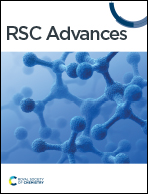Growth of nanostructured Cu3Al alloy films by magnetron sputtering for non-enzymatic glucose-sensing applications†
Abstract
Enzymatic glucose sensors usually exhibit excellent sensitivity and selectivity but suffer from poor stability due to the negative influence of temperature and humidity on enzyme molecules. As compared to enzymatic glucose sensors, non-enzymatic counterparts are generally more stable but are facing challenges in concurrently improving both sensitivity and selectivity of a trace amount of glucose molecules in physiological samples such as saliva and sweat. Here, a novel non-enzymatic glucose sensor based on nanostructured Cu3Al alloy films has been fabricated by a facile magnetron-sputtering followed by controllable electrochemical etching approach. Since the metal Al is more reductive than Cu, by selectively etching aluminum in the Cu3Al alloys, nanostructured alloy films were obtained with increased surface contact area and electrocatalytic active sites which resulted in enhanced glucose-sensing performance. Thus, non-enzymatic glucose sensors based on nanostructured Cu3Al alloy films not only exhibited a high sensitivity of 1680 μA mM−1 cm−2 but also achieved a reliable selectivity to glucose without interference by other species in physiological samples. Consequently, this study sparked the potential for the development of non-enzymatic biosensors for the continuous monitoring of blood glucose levels with high sensitivity and impressive selectivity for glucose molecules.



 Please wait while we load your content...
Please wait while we load your content...